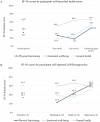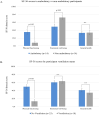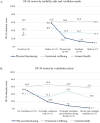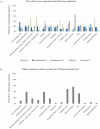Exploring Quality of Life in Adults Living With Late-onset Pompe Disease: A Combined Quantitative and Qualitative Analysis of Patient Perceptions from Australia, France, Italy, and the Netherlands
- PMID: 39758431
- PMCID: PMC11699855
- DOI: 10.36469/001c.126018
Exploring Quality of Life in Adults Living With Late-onset Pompe Disease: A Combined Quantitative and Qualitative Analysis of Patient Perceptions from Australia, France, Italy, and the Netherlands
Abstract
Background: Late-onset Pompe disease (LOPD) is a rare, autosomal recessive metabolic disorder that is heterogeneous in disease presentation and progression. People with LOPD report a significantly lower physical, psychological, and social quality of life (QoL) than the general population. Objectives: This study investigated how individuals' self-reported LOPD status (improving, stable, declining) relates to their QoL. Participant experiences such as use of mobility or ventilation aids, caregivers, symptomology, and daily life impacts were also characterized. Methods: A 2-part observational study was conducted online between October and December 2023 using the 36-item short-form tool (SF-36) and a survey. Adults with LOPD (N=41) from Australia, France, Italy, and the Netherlands were recruited. Results: Participants reporting "declining" LOPD status (56%) had lower physical functioning SF-36 scores than those reporting as "stable" or "improving." Those self-reporting as stable or improving often described an acceptance of declining health in their responses. Physical functioning scores were generally stable in respondents who had been receiving enzyme replacement therapy (ERT) for 1-15 years, but those who had received ERT for >15 years had lower scores. Requiring ventilation and mobility aids had additive negative impacts on physical functioning. Difficulty swallowing, speaking, and scoliosis were the most burdensome symptoms reported by those on ERT for >15-25 years. Discussion: These results demonstrate the humanistic burden of LOPD; through declining physical functioning SF-36 scores over increasing time and increased use of aids, and also through factors related to self-reported LOPD status (where declining status was associated with lower scores) and symptomology variances. Taken holistically, these areas are valuable to explore when informing optimized care. Among a largely declining cohort, even those not self-reporting decline often assumed future deterioration, highlighting the need for improved therapies and the potential to initiate or switch ERT based on evolving symptomology and daily life impacts. Conclusion: Our results indicate that progressing LOPD leads to loss of QoL in ways that relate to time, use of aids, evolving symptomology, and the patient's own perspective. A holistic approach to assessing the individual can help ensure relevant factors are investigated and held in balance, supporting optimized care.
Keywords: emotional wellbeing; late-onset Pompe disease; patient perception; patient-reported outcomes; physical functioning; quality of life.
Figures





Similar articles
-
Switching treatment to cipaglucosidase alfa plus miglustat positively affects patient-reported outcome measures in patients with late-onset Pompe disease.J Patient Rep Outcomes. 2024 Nov 13;8(1):132. doi: 10.1186/s41687-024-00805-w. J Patient Rep Outcomes. 2024. PMID: 39535661 Free PMC article. Clinical Trial.
-
Association between under-dose of enzyme replacement therapy and quality of life in adults with late-onset Pompe disease in China: A retrospective matched cohort study.PLoS One. 2024 Sep 17;19(9):e0310534. doi: 10.1371/journal.pone.0310534. eCollection 2024. PLoS One. 2024. PMID: 39288112 Free PMC article.
-
Quality of life and its contributors among adults with late-onset Pompe disease in China.Orphanet J Rare Dis. 2021 May 1;16(1):199. doi: 10.1186/s13023-021-01836-y. Orphanet J Rare Dis. 2021. PMID: 33933104 Free PMC article.
-
Comparison of recent pivotal recommendations for the diagnosis and treatment of late-onset Pompe disease using diagnostic nodes-the Pompe disease burden scale.J Neurol. 2019 Aug;266(8):2010-2017. doi: 10.1007/s00415-019-09373-2. Epub 2019 May 18. J Neurol. 2019. PMID: 31104135 Review.
-
A Systematic Review and Meta-Analysis of Enzyme Replacement Therapy in Late-Onset Pompe Disease.J Clin Med. 2021 Oct 21;10(21):4828. doi: 10.3390/jcm10214828. J Clin Med. 2021. PMID: 34768348 Free PMC article. Review.
References
-
- A comprehensive update on late-onset Pompe disease. Labella B., Cotti Piccinelli S., Risi B.., et al. 2023Biomolecules. 13(9) doi: 10.3390/biom13091279. https://doi.org/10.3390/biom13091279 - DOI - DOI - PMC - PubMed
-
- The emerging phenotype of late-onset Pompe disease: a systematic literature review. Chan J., Desai A.K., Kazi Z.B.., et al. 2017Mol Genet Metab. 120(3):163–172. doi: 10.1016/j.ymgme.2016.12.004. https://doi.org/10.1016/j.ymgme.2016.12.004 - DOI - DOI - PubMed
-
- Molecular genetics of Pompe disease: a comprehensive overview. Peruzzo P., Pavan E., Dardis A. 2019Ann Transl Med. 7(13):278. doi: 10.21037/atm.2019.04.13. https://doi.org/10.21037/atm.2019.04.13 - DOI - DOI - PMC - PubMed
-
- (HGMD®) HGMD HGMD® home page. [2020-8-24]. http://www.hgmd.cf.ac.uk/ac/
-
- Toward deconstructing the phenotype of late-onset Pompe disease. Schüller A., Wenninger S., Strigl-Pill N., Schoser B. 2012Am J Med Genet C Semin Med Genet. 160c(1):80–88. doi: 10.1002/ajmg.c.31322. https://doi.org/10.1002/ajmg.c.31322 - DOI - DOI - PubMed
LinkOut - more resources
Full Text Sources
